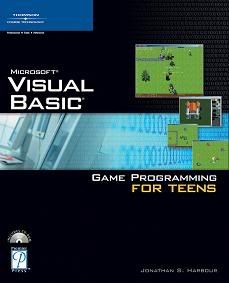Share

Author(s): Jonathan S. Harbour
Publisher: Course Technology PTR
Year: 2005
ISBN: 1-59200-587-X
Language: English
File type: PDF
Pages: 392
Size (for download): 7.41 MB
This book teaches you how to create your own role-playing game (RPG) using Visual Basic and DirectX.I teach you,step-by-step,how to construct each part ofthe game using DirectX components such as Direct3D.Ifyou think RPGs are fun to play,wait until you start working on your very own! Constructing an RPG is far more interesting than playing one, because you are in complete control over the RPG world,and you can let your imagination loose to create adventures for others to enjoy.
Before you can get to the point where you can design an adventure and build an RPG with Visual Basic,you need to learn the language and get up to speed on DirectX.My goal with this book is to teach you just what you need to know in order to make this happen,without going into detail.You learn what you need to know to construct an RPG and nothing more.
You might choose to use a product such as RPG Maker, rather than writing your own RPG with Visual Basic.That is certainly a good alternative,but wouldn’t it be more interesting to have complete control over how the game works? Certainly you can create many complete RPGs of your own design with RPG Maker in the time it takes to build just one RPG from scratch and doing all of your own programming. But after writing your own code,you have learned a promising skillâ€â€game programming! In addition,you have complete creative control over how the game operates.
This book reads like a hobby book, with no pressure and limited goals, because the primary purpose is to help you have fun learning about game programming. Typing long source-code listings out of a book is not fun,so I don’t ask you to do that in every single chapter. Instead, you learn to write short programs to demonstrate the major topics in each chapter, and over time you get the hang of it. There is no memorization required here,as I’m a firm believer that repetitionâ€â€practiceâ€â€is the best way to learn,not theory and memorization.
TABLE OF CONTENT:
Chapter 01 - Getting Started with Visual Basic
Chapter 02 - Your First DirectX Program
Chapter 03 - Designing the Game
Chapter 04 - Core Technique: Drawing Bitmaps
Chapter 05 - Level Editing with Mappy
Chapter 06 - The Basics of Tile-Based Scrolling
Chapter 07 - Scrolling the Game World
Chapter 08 - Advanced Scrolling Techniques
Chapter 09 - Core Technique: Drawing Sprites
Chapter 10 - Core Technique: Animating Sprites
Chapter 11 - Core Technique: User Input
Chapter 12 - Walking Around in the Game World
Chapter 13 - Core Technique: Drawing Text
Chapter 14 - Core Technique: Collision Detection
Chapter 15 - Creating the Character Classes
Chapter 16 - Adding NPCs to the Game World
Chapter 17 - Talking with NPCs
Chapter 18 - Engaging in Combat with NPCs
Chapter 19 - Adding Scenery to the Game World
Chapter 20 - Core Technique: Sound Effects
Chapter 21 - Core Technique: Background Music